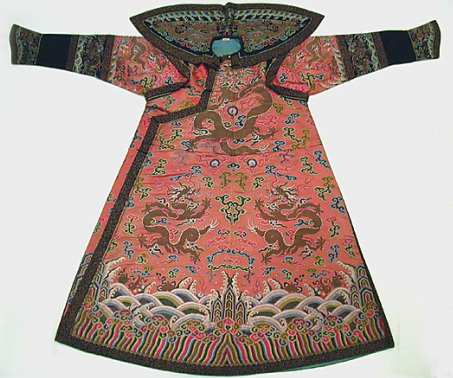Origins
The production and weaving of silk has been around since before record, it appears in many ancient legends. The silk industry began in China, the oldest records of it appear in the middle of the 3rd millennium BCE. Around this time was when the people in rural China discovered the use of the silkworm’s cocoon. Silk rapidly became very significant in the Chinese economy. Legend says that the wife of the Yellow Emperor, Huangdi, was the one who educated the people on the art of making silk; though out history she has always been associated with sericulture, the making of silk. The weaving of the silk textiles is thought to have existed back in the Shang dynasty, remnants of silk have been found in the tombs from the 4th-3rd centuries BCE; here they found the first complete silk garment.
Many Chinese dynasties have contributed to the production of silk, the Song dynasty achieved the perfection of a product called kesi. Kesi is a fine silk textile that is woven on a small loom, with a needle as a shuttle. The technique was invented by the Sogdians, it was improved by the Uighurs, then modified again by the Chinese in the 11th century. They used kesi for robes, silk panels, and scroll covers and for translating painting into tapestry. During the Yuan dynasty, kesi was exported to Europe, where they were used to embellish cathedral vestments.
In the Han dynasty silk became one of China’s best, and most wanted, exports. The caravan route along Asia, called the silk road, brought silk to Syria and all the way to Rome. Textiles from the Han dynasty have been found in Egypt, northern Mongolia, and at Loulan. There is writing that suggests the practice of sericulture had traveled all the way to the island of Kos in the 4th century BCE. Unfortunately the art they made was lost, but silk was reintroduced to them in the 6th century CE. Silk was used my the Han dynasty as diplomatic gifts, as well as to buy off the menacing nomads to weaken them by giving them a little taste of luxury.
The textiles that were recovered from the Han dynasty from Mawangdui show the progress of the weaving traditions of brocade, embroidery, gauze, pain weaves, and damasks. Findings elsewhere have only been damasks, which are finely woven textiles with many different colors and patterns. They are usually geometric, the zigzag lozenge is the most common pattern. The patters were transmitted from woven materials to the Luoyang mirrors and then appeared in paintings, silk, and other art forms. Thus there were many similarities throughout the art of the Han dynasty.
The Ming and Qing dynasty textiles are a great representation of the Chinese love of detail, color, and fine craftsmanship. The textile patterns are full of flowers and dragons, there were many types of Qing robes. The chaofu which was a very elaborate court ceremonial dress, the emperors robe was admired. The caifu was a semiformal court dress associated with imperial use. Silk represented imperialism, so thus considered luxurious. The emperors uses of silk is the origin of the idea that silk is “for the best”.
Many Chinese dynasties have contributed to the production of silk, the Song dynasty achieved the perfection of a product called kesi. Kesi is a fine silk textile that is woven on a small loom, with a needle as a shuttle. The technique was invented by the Sogdians, it was improved by the Uighurs, then modified again by the Chinese in the 11th century. They used kesi for robes, silk panels, and scroll covers and for translating painting into tapestry. During the Yuan dynasty, kesi was exported to Europe, where they were used to embellish cathedral vestments.
In the Han dynasty silk became one of China’s best, and most wanted, exports. The caravan route along Asia, called the silk road, brought silk to Syria and all the way to Rome. Textiles from the Han dynasty have been found in Egypt, northern Mongolia, and at Loulan. There is writing that suggests the practice of sericulture had traveled all the way to the island of Kos in the 4th century BCE. Unfortunately the art they made was lost, but silk was reintroduced to them in the 6th century CE. Silk was used my the Han dynasty as diplomatic gifts, as well as to buy off the menacing nomads to weaken them by giving them a little taste of luxury.
The textiles that were recovered from the Han dynasty from Mawangdui show the progress of the weaving traditions of brocade, embroidery, gauze, pain weaves, and damasks. Findings elsewhere have only been damasks, which are finely woven textiles with many different colors and patterns. They are usually geometric, the zigzag lozenge is the most common pattern. The patters were transmitted from woven materials to the Luoyang mirrors and then appeared in paintings, silk, and other art forms. Thus there were many similarities throughout the art of the Han dynasty.
The Ming and Qing dynasty textiles are a great representation of the Chinese love of detail, color, and fine craftsmanship. The textile patterns are full of flowers and dragons, there were many types of Qing robes. The chaofu which was a very elaborate court ceremonial dress, the emperors robe was admired. The caifu was a semiformal court dress associated with imperial use. Silk represented imperialism, so thus considered luxurious. The emperors uses of silk is the origin of the idea that silk is “for the best”.

